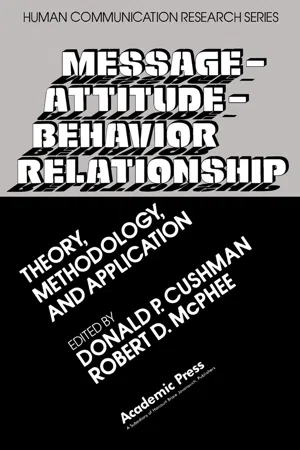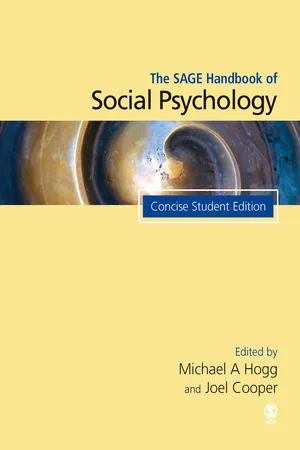Psychology
Attitudes and Behavior
Attitudes refer to individuals' evaluations and feelings toward people, objects, and ideas, while behavior encompasses the actions and responses that individuals exhibit. In psychology, the relationship between attitudes and behavior is a key area of study, exploring how attitudes influence behavior and the factors that mediate this relationship. Understanding this connection is crucial for predicting and influencing human actions.
Written by Perlego with AI-assistance
Related key terms
1 of 5
12 Key excerpts on "Attitudes and Behavior"
- eBook - PDF
Attitudes and Related Psychosocial Constructs
Theories, Assessment, and Research
- Lewis Aiken(Author)
- 2002(Publication Date)
- SAGE Publications, Inc(Publisher)
As is true of many other constructs in psychology and sociology, the term attitude, which was characterized by Allport (1935) Definitions, History, and Behavior Prediction 3 as probably the most distinctive and indispensable concept in contempo-rary American social psychology (p. 798; see also Hartmann, 1939), has varied in meaning to some extent from one researcher to another. The fact that attitudes cannot be observed directly but are inferred from behavior is made explicit in Gagne and Briggs's (1974) description of an attitude as an internal state which affects an individual's choice of action toward some ob-ject, person, or event (p. 62). Underscoring the relationship between atti-tudes and beliefs is Milton Rokeach's (1968) definition of an attitude as a relatively enduring organization of beliefs around an object or situation pre-disposing one to respond in some preferential manner (p. 112). Empha-sizing a tripartite (cognitive, affective, conative) classification that goes back to the ancient Greek philosophers, Eagly and Chaiken (1993) defined attitudes as tendencies to evaluate an entity with some degree of favor or disfavor, ordinarily expressed in cognitive, affective, and behavioral re-sponses (p. 155). As indicated by this definition, attitudes have cognitive (beliefs, knowledge, expectations, or perceived associations between atti-tude objects and attributes), affective (feelings, moods, motives, and emo-tions and associated physiological changes), and performance (behavioral or action, both intended and actual) components (McGuire, 1985). As out-lined in Table 1.1, each of these three structural components can be ex-pressed in either a verbal or a nonverbal response mode. In addition to the three structural components, attitudes may be viewed as having various motivational functions, among which are knowledge, instru-mentality, ego-defense, value-expression, consistency, and uniqueness. - eBook - ePub
Attitudes Toward Handicapped Students
Professional, Peer, and Parent Reactions
- Marcia D. Horne(Author)
- 2012(Publication Date)
- Routledge(Publisher)
A social attitude... may be defined as a set of evaluative categorizations formed toward an object or class of objects as the individual learns, in interaction with others, about his environment including evaluations of other persons. Through attitude formation, the individual relates himself, psychologically, to these objects. His attitudes become constituent parts of his self (ego) system. By definition, therefore, attitudes have emotional and motivational aspects inseparably intertwined with cognitive content (Sherif, Sherif & Nebergall, 1965, p. 20).An attitude is a tendency to act toward or against some environmental factor which becomes thereby a positive or negative value (Bogardus, 1931, p. 52). An attitude is an idea charged with emotion which predisposes a class of actions to a particular class of social situations (Triandis, 1971, p. 2). An attitude is: 1. an implicit response 2. which is both (a) anticipatory and (b) mediating in reference to patterns of overt responses, 3. which is evoked (a) by a variety of stimulus patterns (b) as a result of previous learning or of gradients of generalization and discrimination, 4. which is itself cue- and drive-producing, 5. and which is considered socially significant in the individual’ s society (Doob, 1967, p. 43).The first two definitions refer to a readiness to respond to a situation; the second incorporates the notion that attitudes are a learned response with enduring qualities. The next two point out that an attitude results in positive or negative behavior. The final definition illustrates a behavioral definition of attitudes.There are many other definitions in the literature because, “... social psychologists have tried to make their definition of attitude both a definition and theory of the concept” (Kiesler, Collins, & Miller, 1969, p. 4). Each definition is tailored to the psychologist’ s theoretical construct. Despite these differences most researchers would agree that an attitude can be described as, “... a learned predisposition to respond in a consistently favorable or unfavorable manner with respect to a given object” (Fishbein & Ajzen, 1975, p. 6). - eBook - PDF
Cognitive Consistency
Motivational Antecedents and Behavioral Consequents
- Shel Feldman(Author)
- 2013(Publication Date)
- Academic Press(Publisher)
Thus our problem is not simply to investigate relationships between attitude and behavior; rather, we must concern ourselves with at least four things: attitudes, beliefs, behavioral intentions, and be-havior. Our problem thus becomes the investigation of the interre-lationships among all of these four concepts. While considerable progress has been made in understanding the relationships between beliefs and attitudes, little has been done in investigating the re-lationships between beliefs and behavioral intentions, Attitudes and Behavioral intentions, or any of these three with behavior per se. In the remainder of this paper, I should like to consider some of these interrelationships. Beliefs, Attitudes, and Behavior 205 THE RELATIONS BETWEEN BELIEFS AND ATTITUDES (I.E., COGNITION AND A F F E C T ) As was mentioned above, it appears that we now have fairly conclusive evidence that a person's attitude toward any object can be seen as a function of his beliefs about the object (i.e., the probability or improbability that the object has a specific relation-ship with some other object, value, concept, or goal) and the evaluative aspects of those beliefs (i.e., the subject's attitude toward, or evaluation of, the related object). For example, Rosenberg (1956) has demonstrated that indi-vidual's attitudes toward the policy of allowing communists to speak in public are highly related to their beliefs that this policy will lead to or block the attainment of certain valued states and their evaluations of these valued states. Zajonc (1954) has shown that individuals' attitudes toward a Picasso painting are a function of their beliefs about the qualities, characteristics, and at-tributes of the painting, and their evaluations of these character-istics, qualities, and attributes. - eBook - PDF
Message—Attitude—Behavior Relationship
Theory, Methodology, and Application
- Donald P. Cushman, Robert D. McPhee, Donald P. Cushman, Robert D. McPhee(Authors)
- 2013(Publication Date)
- Academic Press(Publisher)
A major distinction among variables is suggested by the title of Fishbein and Ajzen's Belief, Attitude, Intention, and Behavior (1975). Rejecting a tricomponential view of attitude, Fishbein initially defined attitude, following Thurstone, as the amount of affect for or against a psychological object [1967, p. 478]. The usual cognitive component is redefined as belief : the subjective probability of a relation be-tween the object of the belief and some other object, value, concept, or attribute [Fishbein & Ajzen, 1975, p. 131]. The conative component of attitude is termed behavioral intention, defined as a person's location on a subjective prob-ability dimension involving a relation between him and some action [p. 288]. Fishbein separates these components of attitude in order to stipulate a causal chain involving them and behavior. Behaviors (or volitionally controlled be-haviors) are determined by behavioral intentions, which are functions of atti-tudes toward the acts in question (along with a special class of social normative beliefs, to be dealt with later). Attitudes themselves are functionally related to beliefs, which, as initial psychological variables in this chain, are determined by (interpreted) experience and messages. Attitude toward the act is one expression of Fishbein's general move-ment toward conceptual sophistication, summarized most recently in Ajzen and Fishbein (1977). These authors argue that Attitudes and Behaviors may be specified by considering them as consisting of four different elements: the action, the target at which action is directed, the context in which action is performed, and the time at which it is performed [p. 889]. Particular behaviors usually have specific values for each of these elements ; to index behavior more generally, a researcher may form a multiple-act criterion by summing over varying values of one or more of the four elements mentioned. - eBook - ePub
Predicting and Changing Behavior
The Reasoned Action Approach
- Martin Fishbein, Icek Ajzen(Authors)
- 2011(Publication Date)
- Psychology Press(Publisher)
General Attitudes and the Prediction of Behavior 1 As we noted in Chapter 3, more than any other construct, attitude occupies a central role in social psychological theory and research. In the early days of attitude research, most investigators accepted as a given that human behavior is guided by social attitudes. In fact, the field of social psychology was originally defined as the scientific study of attitudes (Thomas & Znaniecki, 1918; Watson, 1925) because it was assumed that attitude was the key to understanding human behavior. Early work with the attitude construct gave no reason to doubt this assumption. Applying newly developed methods to assess attitudes, it was shown that groups known to differ in their patterns of behavior in a given domain also held correspondingly different attitudes. Thus, for example, divinity students were found to hold more favorable attitudes toward the church than other college students (Thurstone & Chave, 1929); military training groups, veterans, and conservative political groups had more favorable attitudes toward war than labor groups and professional men (Stagner, 1942); and businessmen were found to be more opposed to the prohibition of alcohol than were Methodists (Smith, 1932; see also Bird, 1940). Indeed, in his influential early review of the attitude literature, Allport (1935) stated that “the concept of attitude is probably the most distinctive and indispensable concept in contemporary American social psychology. No other term appears more frequently in experimental and theoretical literature… This … concept has been so widely adopted that it has virtually established itself as the keystone in the edifice of American social psychology” (p - eBook - PDF
The Psychology of Influence
Theory, research and practice
- Joop van der Pligt, Michael Vliek(Authors)
- 2016(Publication Date)
- Routledge(Publisher)
In everyday speech, we talk about ‘opinions’, ‘feelings’, ‘preferences’ and ‘convictions’. All these are evaluative responses that fall under the generic heading ‘attitude’. To put it another way, attitudes refer to people’s evaluative responses – positive or negative – to a stimulus, the so-called attitude object. An attitude object can be a person (a politician, your landlord, yourself), an organisation (the tax authority, social services) or a situation (a party, a lesson at school), but also a product (food, cosmetics) or an idea (halting immigration, raising the motorway speed limit). Defined in this way, it seems logical that attitudes directly relate to behaviour: people in 18 Attitudes and behaviour the UK with a positive attitude towards the Conservative Party and a negative attitude towards Labour are more likely to vote Conservative, right? Even though the answer is quite likely yes, it isn’t as straightforward as it seems, which is why the study of attitudes and attitude change has one of the longest histories in social psychology (for a review, see Briñol & Petty, 2012). Indeed, one of the founders of social psychology, Gordon Allport (1935), went so far as to call attitudes the single most indispensable concept in the field. The origins of research in this field date back to the 1920s and 1930s, and in its early days it was concerned primarily with attitude measurement (Bogardus, 1925; Thurstone & Chave, 1929; Likert, 1932), with the initial discussion revolving around whether or not they are actually measurable (Thurstone’s famous article of 1928 is entitled ‘Attitudes can be measured’). There was also interest in how attitudes affect behaviour, with LaPiere (1934) providing a classic example. In an era in which negative racial stereotypes about Chinese people were prevalent, he visited a number of restaurants in the southern United States in the company of a Chinese man and woman. - The study of attitudes has been fueled by the belief that there is a strong relationship between attitudes and behaviour. If such a linear relationship exists, thought the social psychologists, it may be possible to gain insight, if not predict, the individual’s behaviour. Allport (1954) viewed attitudes as ‘the most distinctive and indispensable concept in social psychology’. Psychologists are also interested because the implication is that one can influence behavioural changes by changing attitudes.The literature reveals numerous definitions of what attitudes are, each reflecting the belief system of the authors. Consequently psychologists are unlikely to agree upon any one definition. I wish to take a brief look at the various perspectives rather than to deliberate over the many definitions which readers may find in the literature. Hopefully from this exploration readers will be able to decide for themselves where they, or the author stands.Secord and Backman (1964) propose that most definitions are comprised of three components:
Attitudes – a structural approach
1. The cognitive component, what the person thinks about a certain subject. 2. The affective component, what the person feels about a certain subject. 3. The behavioural component, how the person behaves towards a certain subject in the light of the individual’s thoughts and feelings.The simplicity of the view is rather naive as it is well known that human nature is less reliable or predictable due to the many individual and situational factors involved. One of the most reported studies is that by La Piere (1934). Travelling with a Chinese couple through the United States of America, he monitored the expression of cultural attitudes and prejudices that the couple experienced in attempting to obtain accommodation. La Piere writes that in 10,000 miles of travel discrimination was encountered once and there was no observation of prejudice. Following the travel, letters were then sent to the establishments which had been visited asking for their response to a request to provide accommodation and food to members of the Chinese culture. Results reveal a different picture from the actual experiences. Over 90% replied they would not offer hospitality, one replied they would offer hospitality and the remainder replied that they would have to take circumstances at the time into account. Presumably the circumstances being referred to are the personal judgements being made about the individuals in front of them and the circumstances at the time. Therefore perhaps all that can be proposed is that attitudes may demonstrate a predisposition towards a certain subject. - James T. Tedeschi(Author)
- 2013(Publication Date)
- Academic Press(Publisher)
ISBN: 0-12-685180-8 108 Jerald M. Jellison Traditional Conception of Internalized Attitudes The concept of attitude has a long and varied history (cf. Fleming, 1967), but by the 1950s there was a general consensus about the definition and conception of attitude. Attitude was typically defined as a learned predisposition to respond favorably or unfavorably to a class of objects. Implicit in the definition was the assumption that an attitude was endur-ing and would produce consistency in the individual's response to the at-titude object across time and situations. A common model of attitude assumed a cognitive component based on information or rational argu-ments, from which the evaluative or affective component was derived, and which led to the behavioral· component and the associated overt ac-tions (Krech, Crutchfield, & Ballachey, 1962). This tripartite distinction (i.e., cognition, affect, behavior) presents a rational and linear sequence from internal beliefs and attitydes to overt behavior. Conceptions such as these dominated the field of social psychology in the midtwentieth cen-tury and produced a wide variety of research. The primary research thrust concerned theoretical rather than practi-cal questions and was carried out by a group of researchers at Yale University (Hovland, Janis, & Kelley, 1953). This research examined fac-tors that could effect change in the evaluative component, which became synonymous with the concept of attitude. Scores of studies were con-ducted and involved manipulations of the amount, kind, and source of in-formation to which an individual was exposed and the effect on attitude change (McGuire, 1969). On the whole this research provided evidence that changes in the cognitive component could affect the evaluative or at-titudinal component. Research on the causal relationship between the evaluative compo-nent and the behavioral component was far less common and far less sup-portive.- eBook - PDF
- Ulrich Ammon, Norbert Dittmar, Klaus J. Mattheier, Peter Trudgill, Ulrich Ammon, Norbert Dittmar, Klaus J. Mattheier, Peter Trudgill(Authors)
- 2020(Publication Date)
- De Gruyter Mouton(Publisher)
'Attitude' is derived from two roots: from the late Latin word 'aptitudo', meaning readiness, inclina-tion, and — via the Italian 'atto' — from the Latin 'actus', meaning action, behaviour. Hence, attitude has a lot to do with behav-iour, but it is not behaviour; attitude means readiness to behaviour. Fishbein and Ajzen (1975, 6) define 'attitude' as a predisposition to respond in a consistently favourable or unfavourable manner with respect to a given object — this object may be a person, a group, an event, a situation, a fact, a language variety, a linguistic variant etc. A first impor-tant implication of this definition is that an attitude as such is not directly perceivable or measurable. It is a mental and neural state of readiness (Allport 1954, 24), a hypothetical construct which mediates between stimulus and response. However, hypothetical does not mean empty or vague. On the contrary, the definition implies both structure and quality. Regarding structure, the presence of a number of components is assumed; as to quality, consistency is the central criterion. 3. Structure The construct of attitude is often thought to consist of three components, a cognitive one, an evaluative one and a conative one. The reasoning is that before somebody can react consistently to an object, he first has to know something about it. Only then can he evaluate the object positively or negatively. Finally, this knowledge and these feelings are accom-panied by behavioural intentions. 3.1. The Cognitive Component The cognitive component of the attitude in-cludes all kinds of knowledge one has about the attitude object. This knowledge is com-posed of so-called beliefs. Beliefs are the smallest cognitive units of the conceptual structure. Fishbein and Ajzen (1975, 131) de-fine them as a person's subjective probabi-lity judgments concerning some discriminable aspect of his world. - eBook - PDF
The SAGE Handbook of Social Psychology
Concise Student Edition
- Michael A Hogg, Joel Cooper, Michael A Hogg, Joel Cooper(Authors)
- 2007(Publication Date)
- SAGE Publications Ltd(Publisher)
It is difficult to imagine a psychological world with-out attitudes. One would go about daily life without the ability to think in terms of ‘good’ and ‘bad’, ‘desirable’ and ‘undesirable’, or ‘approach’ and ‘avoid’. There would be no activation of positivity or approach tendencies upon encounter-ing objects that would engender positive outcomes, but, perhaps more seriously, there would also be no mental faculty for avoiding negative objects in one’s environment. Our environment would make little sense to us; the world would be a cacophony of meaningless blessings and curses. Existence would be truly chaotic, and probably quite short. For these reasons, the attitude construct has proven indispensable in social psychology’s under-standing of why we think, feel, and do the things we do. Indeed, the field of social psychology was once defined as the study of attitudes (Thomas and Znaniecki, 1918). Even a quick perusal of the various books and review chapters on the attitude construct reveals that virtually everyone begins with broad assertions about how pervasive evalu-ation is in everyday life (e.g., Fazio, 2001; Petty and Cacioppo, 1981). Osgood et al. (1957) showed that most of the meaning in language comes from eval-uation. Certainly, attitudes have occupied a central position in social psychology for decades (Allport, 1935; Doob, 1947; McGuire, 1985). How do we come to evaluate objects in our environment as positive or negative? What are the functions of these evaluations? How are they represented in memory, and how does this repre-sentation affect the ways they operate in predicting behavior? History has proven these questions to be some of the most important, and challenging, of social psychology. Our goal in this chapter is to describe some of the ways in which researchers have approached these questions about the nature of attitudes and to relate some of the insights that the field has collected in nearly 100 years. - eBook - ePub
- J Richard Eiser, Joop van der Pligt(Authors)
- 2015(Publication Date)
- Psychology Press(Publisher)
not treated as a distinct category by themselves, but are split up between the three categories in the same way as other forms of response.A number of studies based on this model have asked subjects to answer questions about their liking or disliking of an attitude object (‘affect’), their beliefs (‘cognition’) and then compared these measures with each other, and with self-reports of behaviour. Ostrom (1969) conducted such a study using the issue of the Church, whereas Kothandapani (1971) used the issue of contraception. Both concluded that affect, cognition and behaviour were interrelated, although still distinguishable from each other. The debate has since moved to a more sophisticated level with regard to the statistical criteria that are appropriate for distinguishing between sets of intercorrelated items (Breckler, 1984). However, even if we take Ostrom’s and Kothandapani’s conclusions at face value, we are left with a rather muddling state of affairs whereby any observation of a good match between behaviour and verbally expressed attitudes is taken to show that the different components are interrelated and any observation of a poor match is taken to show that the components are distinct.This points to the need for research that explores factors that can make the relationship between the different components higher or lower. Fazio and Zanna (1981) suggest that consistency between behaviour and (the affective component of) attitude is likely to be higher for attitudes acquired through direct, personal experience. Breckler (1984) takes a rather different line, by arguing that some studies may have produced inflated estimates of the associations between affect, cognition and behaviour by relying on self-report measures of the different components, typically without the attitude object being physically present. Breckler points out that this requires subjects to respond not to the object itself, but to its symbolic representation in memory. For this reason, all - Lorelle J. Burton, Drew Westen, Robin M. Kowalski(Authors)
- 2022(Publication Date)
- Wiley(Publisher)
attitude strength The durability of an attitude (its persistence and resistance to change) and its impact on behaviour. attitudinal ambivalence A condition in which an attitude object is associated with conflicting evaluative responses. attitudinal coherence The extent to which an attitude is internally consistent. attribution The process of making inferences about the causes of one’s own and others’ thoughts, feelings and behaviour. attributional style A person’s habitual manner of assigning causes to behaviours or events. augmentation Attributional phenomenon in which people emphasise an internal explanation for a behaviour because it occurred despite situational pressures. Pdf_Folio:1077 CHAPTER 20 Attitudes and social cognition 1077 authoritarian personality A personality type that is prone to hate people who are different or downtrodden. central route A method of persuasion that involves inducing the recipient of a message to think carefully and weigh the arguments. cognitive complexity The intricacy of thoughts about different attitude objects. cognitive dissonance A phenomenon in which a person experiences a discrepancy between an attitude and a behaviour or between an attitude and a new piece of information incongruent with it, which leads to a state of tension and a subsequent change in attitude, behaviour or perception. confirmation bias The tendency to seek out information that confirms one’s hypotheses. consensus In attribution theory, a normative response in a social group. conservation psychology The study of the reciprocal relationships between humans and nature, with a focus on changing attitudes and behaviours to encourage conservation of the environment. consistency In attribution theory, the extent to which a person always responds in the same way to the same stimulus. coping The ways people deal with stressful situations; also called coping mechanisms.
Index pages curate the most relevant extracts from our library of academic textbooks. They’ve been created using an in-house natural language model (NLM), each adding context and meaning to key research topics.











